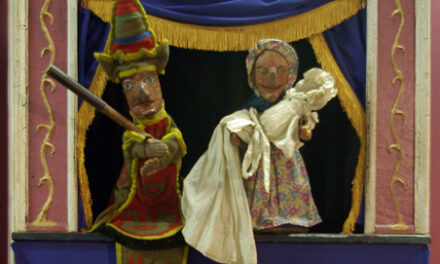The Asheville Lyric Opera gave a heartfelt performance of Puccini’s La Bohéme on Friday night. Henry Murger’s idealistic tale of four starving artists in 1830s Paris was brought to life through the passionate performance of the singers, cleverly constructed sets, and thoughtful lighting design. Even though these elements of the production were strong, problems within the orchestra and chorus plagued the performance.
The four lead characters and their lovers were particularly well sung. Jason Baldwin and Angela Amidei captured the essence of the ardent passion shared by Rodolfo and Mimi. The fiery relationship between Musetta and Marcello was expressed with wit and animation by Dominic Aquilino and Christina Villaverde. Brent Davis and Ardean Landhuis also gave compelling performances as Schaunard and Colline respectively.
The set design was of particular note in this production. It was in a quasi-minimalist vein, with set pieces easily repurposed for different scenes. The rafters in the garret of Act I were manipulated to become the gate of Act III. The sparse sets reflected the poverty of the characters and their ability to make so much out of the little they had.
The lighting design is also worth noting. The concepts were simple, but they deftly enhanced the dramatic aspects of the performance. During much of Act III the performers were silhouetted against the backdrop, increasing the audience’s perception of the alienation that the characters felt. At Mimi’s tragic death at the end of Act IV, the entire stage was bathed in a warm golden light, recalling her line in Act I about her joy in feeling “spring’s first bright sunbeam.”
The biggest issue with the production was the quality of the orchestra. It seemed that at the climax of almost every aria someone in the orchestra would miss a note or have problems with intonation, contributing to diverting attention from the action onstage. There were enough of these obvious mistakes to be truly distracting and as a result to make the entire production less enjoyable. The other distraction was in Act II when the chorus appears. The scene is supposed to depict the commotion of a street in Paris on Christmas Eve, but due to problems with the entrances of the chorus and some imprecision in the orchestra, the scene felt more chaotic and disorganized than even Puccini intended.
Because of the tremendous number of extremely high quality performances mounted all over the world each year, it’s always difficult to judge the quality of a production of an opera as important and widely produced as La Bohéme. Asheville Lyric Opera put on a satisfactory production of this beloved work, and while it was perhaps not the most polished performance one might ever attend, it got to the heart of the story and was, overall, a pleasant experience.











